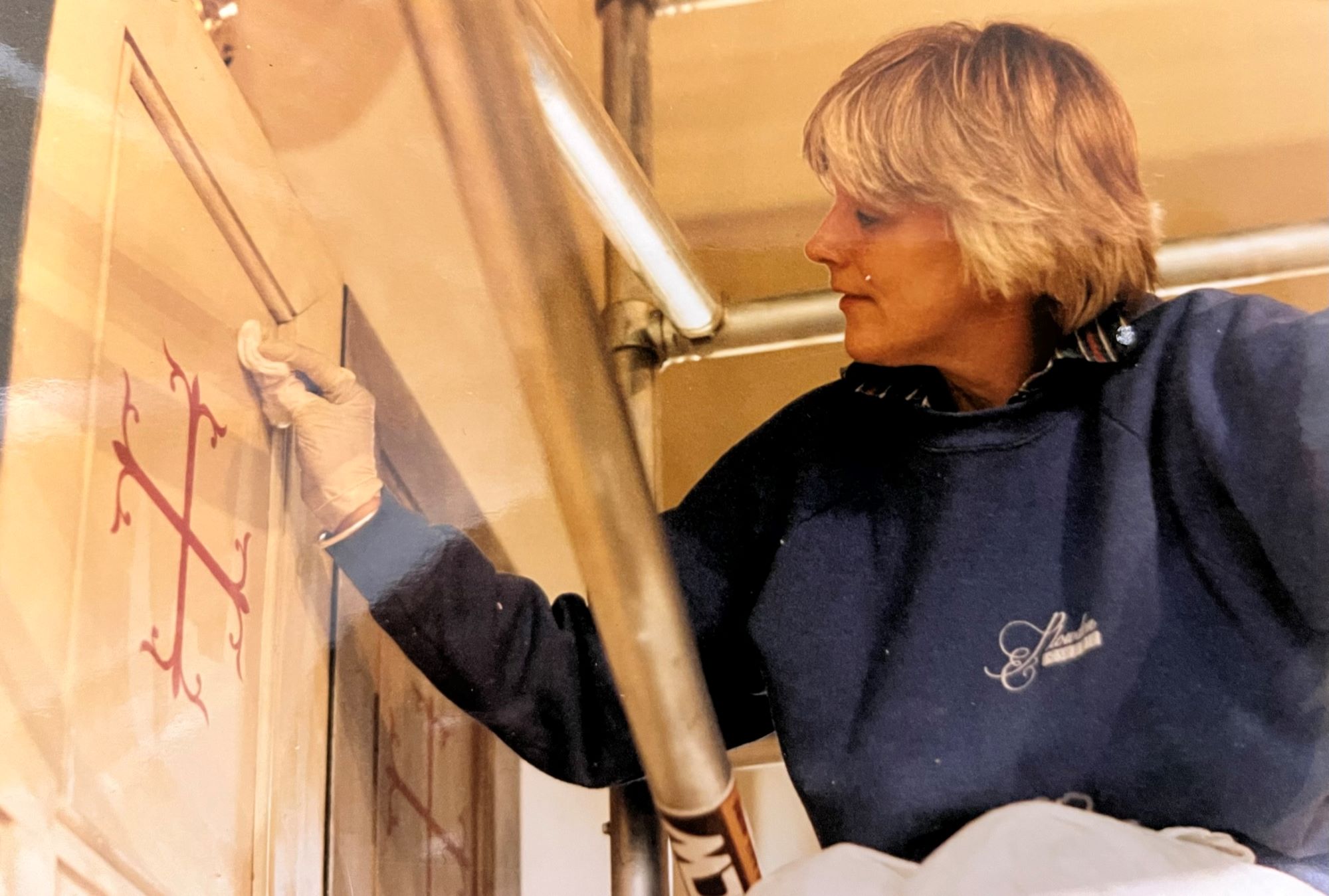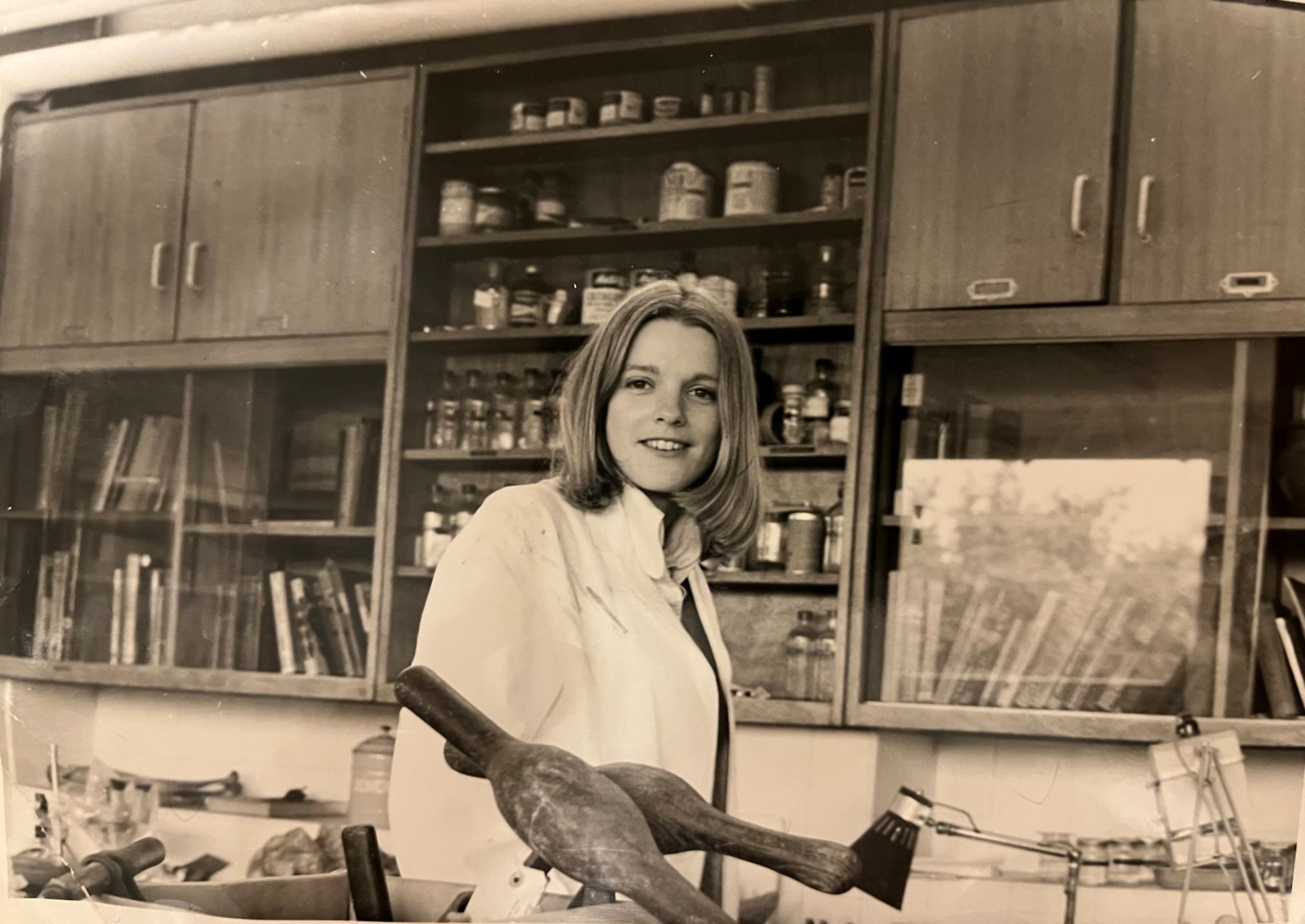Personal Recollections of Pamela Pratt (later French)- Specialist in Conservation of Wallpaintings and Inspiring Teacher 1944 – 2023

In the 1960s, Pam studied conservation at the University of London (now UCL) Institute of Archaeology, and later trained in the conservation of wall paintings at the Istituto Centrale per il Restauro in Rome.
In 1965 (and later excavation seasons), Pam achieved the extraordinarily complex conservation of the wall paintings at the Neolithic site of ÇatalHöyuk, Turkey. In several cases this involved ‘peeling’ a painting to reveal an earlier one beneath. These paintings are now housed in the Museum of Anatolian Civilisations, Ankara.
In the mid-1960s, Pam joined the conservation staff at the University of London Institute of Archaeology, working alongside Ione Gedye and Henry Hodges. She specialised in teaching the conservation of wall paintings and inspired several generations of conservation students from all over the world.
Pam continued to work on archaeological sites in Turkey including Asvan and Anamur, and on wall paintings in churches and other buildings in the UK. When she left the Institute in the early 1970s, she joined Plowden and Smith before moving more permanently to Turkey where her husband, David French, was director of the British School in Ankara. David died in 2017 and sadly Pam’s last few years were affected by Parkinson’s disease.
Liz Pye ACR (Emeritus) writes:
Following a degree in archaeology, I came to the Institute as a conservation student in 1968. Pam was an excellent teacher –she was firm and had high expectations, but her classes were also fun. The practical skills I learnt with her very definitely shaped my career. She was genuinely interested in students and alsovery kind, as I discovered when I had to rush home because my brother was seriously ill.
When I returned to the Institute to join the conservation staff (Ione Gedye, Henry Hodges and Pam), Pam and I worked together. We each taught different aspects of conservation but shared our ideas and our concerns about timetables, admin, lab work and individual students. During this time, we also lived together.
First we shared a flat, then a tiny house, in Fitzrovia. In the flat we lived amicably with its mouseinhabitants but on one night in 1971, wewere forcefully wokenby the bombing of the Post Office Tower just above us (amazingly, no one was hurt). In the house we became intimate with the life cycle of the cockroach, (there was a café nextdoor).
Pam sometimes brought her car to London (the Institute had a free car park in those days) and as this was when the IRA was active, we would regularly crouch down to check underneath it for bombs. We watched Monty Python on a tiny black and white telly and had a phase of reading all the Hornblower novels, and of course we shared confidences.
Gradually our lives moved onand we attended each other’s weddings - Pam made my wedding posy and the following year my husband, Nick, and I drove David to Hertfordto marry Pam. Once Pam moved to Ankara, sadly I seldom saw her, but she remained (and remains) a very important part of my life.
Kathy Tubb ACR (Emeritus) writes:
As a member of the 1975 conservation class at the Institute of Archaeology I was lucky enough to be one of Pamela’s students. She was an inspiring lecturer and skilled in removing wall paintings from their original locations using staccare and strappare techniques. All of our cohort enjoyed the opportunity to be taught these methods by creating our own wall paintings on which to practice their removal.
When Ione Gedye, the head of department, was enquiring about conservation projects for the summer I replied simply, “somewhere warm”. She suggested Turkey working with Pamela. This was the beginning of a lifelong friendship.
In 1973 I was fortunate to learn a great deal from her working in the Ankara Archaeological Museum (as it was then called) on 7th-millenniumBCE wall paintings from the Neolithic city of Çatalhöyuk. Pamela had worked for James Mellaart in the 1960s. These paintings had had layers depicting the same images applied one on top of the other a number of times. Pamela’s extraordinary ability using strappare technique demonstrated how these could be rescued.
In the summers of 1974 and ’75, I was part of her group of conservators that worked at the Roman site of Anemurium in Southern Turkey on the painted decoration of barrel-vaulted tomb interiors. Pamela undertook this work for site director, James Russell. We later worked on part of the Angel Roof Holy Trinity Church, Blythburgh, some of which had been stained due to treatment for woodworm. Pamela had suggested this project for my third-year dissertation. Conservation on the roof entailed a scaffold tower that swayed. At the end of a day’s work, we would feel unsteady on firm ground. Full facemasks were required when we were on the scaffold tower. This caused alarm to parishioners who,if they glimpsed us when we descended, must have thought we looked like aliens.
Our friendship continued over the years. We had children at the same time and Pamela was later godmother to my second child. For many years we met up for pizzas, laughs and chats. When she moved out of London, phone calls kept us in touch. Pamela remained one of my dearest friends. She will be sorely missed.
Frankie Halahan ACR (Emeritus) writes:
I knew Pam as an excellent teacher and as someone verykind and generous as well as exacting. I would probably not be here if it were not for Pam.
In 1974 we were at the site ofAnamour on the Turkish coast. The war in Cyprus was developing so we were expecting to have to leave. I was on my way to get lunch - as conservators often seemed to have to do - and was bitten by a dog lying by the side of the path. I tried to just let it go but Pam would not let me, and took me into the small town to find a doctor, who sewed me up using a No.11 scalpel blade to clear the way:we were interested to know where he got them! During the sewing I could not see much but Pam was very brave and stayed with me, although she did turn green. The doctor also gave me a rabies jab and said I had to have one each day for 14 days. We all left the site soon afterwards and toured Turkey making our way to Ankara, but lots of roads were closed, so it took a while.Pam was brilliant and wherever we got to, she helped me find a hospital or doctor for my jab. I had them all. We found out later that the dog did have rabies, so I was really lucky that Pam made sure I did the right thing!
From my point of view, she was great to work with - kind and not overbearing, but good at guiding and helping and sharing her knowledge about Turkey, Turkish life, archaeology, conservation and everything else very willingly and generously. She was also a good confidence booster for me.
Pilar Caballe Valls writes:
When I started to work at Plowden and Smith’s I had been in the UK for only four years. I was just breaking into the British Conservation worldhaving previously spent time trying to break into the language. I was tense and quiet at work. And then I met Pam!Sheimmediately put me at easeand Icould talk to her about anything.
She was a skilled mediator, loved doing practical work and perfectly understood the issues we conservators had.Her report writing was the best - gentle with clients but assertive.I remember fondly a couple of projects that I worked on with her: one was at the Tower of London consolidating some delaminating paint and plaster. We were freezing cold in our boiler suits and wearing woolly gloves under the vinyl ones (sometimes the brushes would fall off our fingers). Great laughs and conversations made the cold bearable.The other was at the Lloyd’s Register Office in Central London, working on a painted ceiling, lying on our backs,our necks went numb!
She loved her family dearly. She was one of the first to know when I got pregnant with my daughter.
Great tips on how to deal with toddlers I got from Pam! Only good memories… I hope wherever she is, she can feel how loved she is and will be in our hearts.
Ann French ACR writes:
Pam French was my stepmother and without her, my career in textile conservation would probably never have happened or evolved as it has.I knew of ‘conservation’ through her and the several other conservators that passed through the British Institute of Archaeology in Ankara during my childhood there. Even as a child, I was struck by their careful processing of material post-excavation and all the skills that this entailed.It appealed to a child who loved making ‘things’, so when school initiated the process of considering a career, I asked Pam to take me on a visit to the Institute of Archaeology’s teaching laboratories where everyone seemed to be working on (to my teenage eyes) lumps of iron.These lumps did not appeal, and I looked to other career options.But when lightning eventually struck that historic textiles might also need conservation, it was inevitably Pam I turned to again.It was she who asked around and found me the addresses (it was still the era of letter writing) to try.Then when I did get a studentship at the V&A, she provided quiet support and a generous sounding board.Our fields of conservation may have been different but so much was also the same.We always compared notes and loved bemusing my academic father with ‘shop talk’.As I grew older, it was her calm, gentle authority and people skills that I so admired, combined with her formidable hand skills.I shall never forget watching her handling a fragile object.It looked effortless but was, of course, anything but.It was the tragedy of her Parkinson’s that this ability left her. I will miss her.

